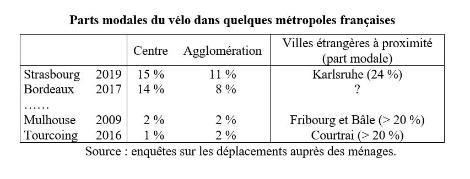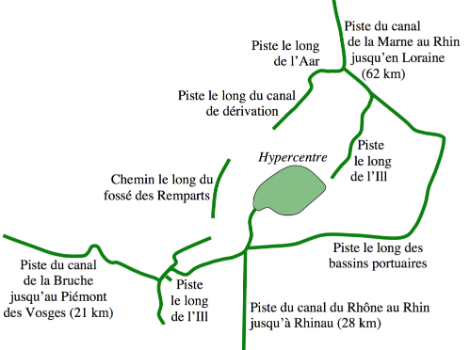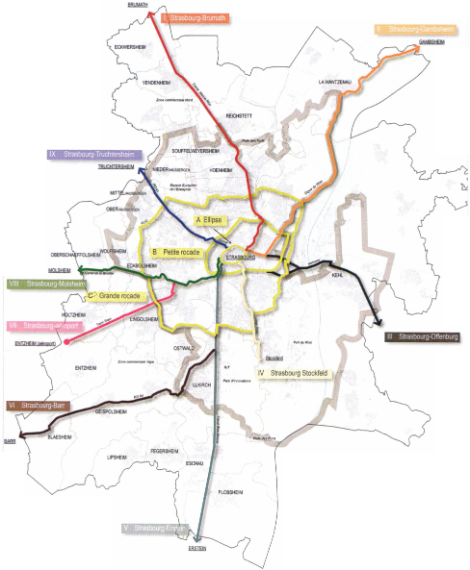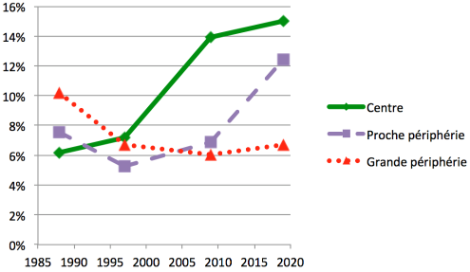Strasbourg, an example of a cycling city
Frédéric Héran, September 2021
Strasbourg, France’s leading cycling city, is a constant source of inspiration for all French cities that want to encourage cycling. With a modal share of 11% for the metropolis and 15% in the centre, it is still far from the most cycling-friendly cities in Europe, but it is still ahead of Bordeaux and Grenoble, which are making rapid progress. How has Strasbourg’s cycling system developed? And can it serve as a model for other French cities ?

In France, Strasbourg has been collecting innovations in the measures taken in favour of cycling, most often, it is true, inspired by the best foreign practices. It is important to dispel a common misconception: if the city has become a cycling destination, it is not because of its proximity to Germany, and in particular to Karlsruhe and its 24% modal share of cycling. In Bordeaux, where cycling is constantly on the increase, the German influence is not very obvious. On the other hand, Mulhouse, which is close to the very cycle-friendly cities of Basel and Freiburg, only has a modest modal share of 2%, and Tourcoing, which is only 12 km from Kortrijk, only has a modal share of 1%. We will therefore have to abandon this simplistic culturalist approach to explain what is happening in Strasbourg. After recalling the context, we will mention some of the stages that have encouraged the development of cycling, and finally present the measures that have made it possible to develop a cycling system.

Context
In the post-war years, Strasbourg was not very different from other large French cities.
The urban form
Today, Strasbourg is a city of 285,000 inhabitants, with a population of 505,000 and an urban area of 785,000. The inherited city, which was enclosed within its ramparts until the end of the 19th century, is very dense. Suburbs took over the urban growth on the outskirts until the middle of the 20th century. Then social housing estates were hastily built on the outskirts in the 1950s and 1970s. Since then, suburban areas have greatly increased the size of the villages on the outskirts. The agglomeration is limited in its expansion to the east by the Rhine and its port. It is located in the densely populated Alsace plain (400 inhabitants/km2). The city is more or less flat (some hills in the west) and has many rivers and canals. Along with a few other large cities, it became an urban community (the CUS) in 1968, taking responsibility for transport from the outset, which facilitated the coherence of its policy in this area. An urban planning agency was created at the same time to support it (later named ADEUS - Agence de développement et d’urbanisme de l’agglomération strasbourgeoise).
Adapting the city to the automobile
To deal with the very rapid growth in motorisation, as in all major French cities, the State took two major initiatives.
1/ As early as the 1950s, it designed a spider web of motorways around the city, to « preserve the centre » from cars while facilitating access. This network is now almost entirely completed, except in the east, as the Port Authority has always refused to sell its land. As a result, a very congested motorway (the A35) bypasses the city centre to the west, less than a kilometre from the cathedral, on what was supposed to remain a green belt (see Figure 1). Today, despite strong opposition, the western bypass is being built, still with the argument of preserving the centre.
2/ As early as 1971, the State drew up a traffic plan with one-way streets, coordination of traffic light junctions and the creation of underground car parks. Two axes, north-south (50,000 vehicles per day) and east-west (30,000 vehicles per day), cross the city centre.
As a result, like everywhere else in France and even in Europe, in the 1960s and 1970s, cycling was in free fall. In this unfavourable context, Strasbourg nevertheless managed to avoid a too severe fall, thanks to a mixture of fortuitous circumstances and deliberate initiatives in which a few personalities, who are worth mentioning, played an eminent role.

History
The years 1970-1990 were crucial for the future of cycling in Strasbourg and deserve to be told.
In the 1970s and 1980s, cycling in the absence of public transport
At the beginning of the 1970s, the government realised that the car would never be able to provide all journeys and that it needed to revive public transport. Since Strasbourg did not have the means to build a metro, the city logically decided to build a tramway in 1975. But the old tramway had only been abolished in 1960, only 12 years earlier. And building a tramway meant eliminating through traffic in the city centre. The city hesitated. A pro-car mayor was elected in 1983 and the decision to build a metro was taken in 1986, but the work was delayed to avoid a construction site during the 1989 elections.
Meanwhile, the city invested little in its public transport: the buses were ageing, stuck in traffic, and were infrequent in the evening and on the outskirts. In the absence of public transport, many Strasburgers keep their bicycles. This is especially true for students, whose population is growing rapidly and whose campus was built on the edge of the city centre on former military land (whereas elsewhere new campuses are generally built on the outskirts).
In 1973, the first pedestrian streets
Two pedestrian areas were developed at this time: the cathedral square and the surrounding area, and the alleys of Petite France. The aim was to enhance the heritage, but the development also contributed to making cycling safer. Despite some initial reluctance and setbacks, the shopkeepers were generally satisfied and ended up asking for them. The pedestrianised streets continued to expand until today they offer a vast and quiet network, outside of the busy pedestrian periods.
From the 1970s, the alert role of the local urban cyclist association
In 1969, following the death of a parishioner on a Solex hit by a car, a young pastor, Jean Chaumien, decided to devote himself to the defence of « light two-wheelers ». He regularly questioned the mayor, Pierre Pflimlin (centre-right), who was reputed to be rather autophobic and did not have a driving licence. In 1975, he created the CADR (Two-wheeler Action Committee). The association frequently carried out educational activities that kept the media and the citizens of Strasbourg interested in cycling.
In 1980, Chaumien founded the FUB (Fédération française des usagers de la bicyclette), whose headquarters are still in Strasbourg, and then in 1983 participated in the creation of the ECF (European Cyclists’ Federation).
1978, a first cycling master plan
With the energy crisis of 1974, as elsewhere in Europe, the government decided to revive cycling, but the urgent need was to invest in public transport, which had been neglected for 30 years. The bicycle still benefited from national subsidies, which only lasted two years (1978 and 1979), halted by budgetary difficulties linked to the second oil crisis, and then by decentralisation. Like a few other cities in France (Grenoble, Lille, Bordeaux, etc.), Strasbourg seized the opportunity to embark on a « two-wheeler master plan ».
To provide food for thought, Chaumien suggested to the mayor that a trip to the Netherlands be organised. In June 1978, accompanied by the president of the Urban Planning Agency, the director of the DDE (Direction départementale de l’Équipement) 1, elected officials and engineers from the city, they went to The Hague, welcomed by the mayor. Pflimlin returned convinced and the decision was taken to build a network of cycle paths, but one that would interfere with car traffic as little as possible. It is therefore mainly planned to establish it along the rivers and canals (see figure 2), in the parks and forests of the CUS or on the widest pavements.

1983, the first « two-way cycle systems
Two-way cycle lanes became widespread in the Netherlands at the end of the 1970s. Chaumien, convinced of their usefulness and safety, proposed that they be installed in Strasbourg. The reluctant city agreed, on condition that they be removed at the slightest accident. There was never any problem and twenty years later the city had three quarters of all such facilities in France. Other cities tried their hand at it until the 2008 decree renamed them two-way cycle lanes and finally made them compulsory in one-way streets in 30 km/h zones.
For a century and a half, a dynamic railway hub
Strasbourg is the third largest provincial railway station (after Lyon and Lille) in terms of passenger traffic. Today, 70,000 people arrive or depart by train every day, 9/10ths of them by TER. In the 1970s and 1980s, a few people got into the habit of having a bicycle at their disposal on arrival so that they could easily get around the city, parked near the station at night, at weekends and during the holidays. As early as the 1980s, there was a bicycle parking area near the station with about twenty spaces, created by CADR, which was guarded and subject to a charge, and which could carry out minor repairs. Since then, the need has continued to grow. Today, 3,000 bicycles are parked in the vicinity of the station, either in open-air hoops or in indoor cycle parks.
In 1989, the election of a bicycle-friendly mayor
In March 1989, Catherine Trautmann (PS) was elected mayor of Strasbourg. She chose to defend a tramway that would eliminate automobile transit in the hypercentre rather than a metro. Having studied Protestant theology (like Jean Chaumien) and being a member of the CADR, she defended humanist values, seeking to build a city for people rather than for cars. It therefore proposed a coherent transport policy, with a reduction in car traffic in favour of public transport, walking and cycling, which implied a thorough redevelopment of the public space around the tramway lines. In November 1994, the first line was inaugurated and was a great success. Trautmann was easily re-elected in March 1995.
Since 1991, the gradual implementation of a « bicycle system
That year, for the first time in France, the urban community appointed Jean-Luc Marchal as a full-time bicycle officer. A historian by training, a journalist and a former member of CADR, he quickly realised that it was not enough to create cycle facilities, but that it was necessary to create what would later be called a « cycle system » 2 by developing all possible initiatives to boost the image and use of cycling. He was effectively supported in his task by ADEUS, several of whose members were in favour of cycling (in particular Michel Messelis, urban planner, and Daniel Hauser, project manager).
This team developed a new « 2-wheel master plan », adopted in 1994, which aimed to develop cycling facilities, including on major roads, by taking space away from the car if necessary.
The bicycle system
Like all other modes of transport, the bicycle is a system with four components: a reliable mode, a sufficiently dense network, a competent user and a set of common rules 3. Here is how a series of measures have helped to develop each of these components.
The mode
Access to a bicycle, and one in good condition, is an essential prerequisite. The city offers a bicycle rental service - Vélhop - for a wide range of durations (from an hour to a year), at a low price, for a limited period of time and with the obligation to return the bicycle to the starting station. This solution has a triple advantage :
1/ it greatly reduces the cost of this service for the community compared to a self-service bicycle system such as Vélib’,
2/ it allows a wide variety of bicycles to be loaned: classic, electric, children’s, two-wheeled, three-wheeled, tandem… and
3/ it encourages residents to acquire a bicycle that is well suited to their needs. There are currently 6,500 bicycles on offer, in 20 automatic stations and 5 shops (or humanised stations).
The city supports several bicycle self-repair workshops, some of which travel with an equipped trailer to social housing estates or to various events. It also lends several types of cargocycles, for a maximum of one month, while the interest of these machines is discovered. A bonus for the electric motorisation of a conventional bicycle or for the purchase of electrically assisted bicycles or cargo bikes has also been introduced, with the bonus varying according to the family income.
The network
The aim is not only to increase the number of cycle lanes, but also to improve traffic flow on all networks, for the benefit of all modes of transport as well as local residents, by increasing the number of 30 km/h zones and meeting zones, by eliminating transit in neighbourhoods and in front of schools, by changing the 4 lanes to 2 lanes (in particular in 2019 on the major axis that is the Avenue des Vosges) in order to avoid building cycle paths on pavements 4, by even slowing down traffic on motorways and urban expressways. The extension of the tramway (6 lines + a BHNS today) contributes greatly to pacifying the city. Since 2011 and the 3rd bicycle master plan, the city has been seeking to develop a structuring network of super bicycle paths (called Vélostras, see figure 3), favouring long journeys, including in the suburbs. Recreational cycle paths have not been forgotten, in particular the « Forts Trail » (85 km) which links the old town of St. Moritz with the new town of St. Moritz. (85 km) which links the old forts surrounding the city.

Secure parking reduces the risk of theft and promotes intermodality. The city has built several large paying « bike parks » (€40 per year) to guarantee a good quality of service: 350 spaces in the city centre, 1,600 spaces near the train station. It has multiplied the number of shelters near the major stations of the public transport network. And it has set thresholds for spaces in new buildings.
The user
The city is working to attract new users to cycling by developing and supporting various services and initiatives (described in the 2019 Action Plan for Active Mobility 5 ), in particular a cycle school for adults, training for schoolchildren to learn how to ride a bike, a « Work by bike » challenge which is proving very successful (382 companies and 11,000 employees involved in 2019), and specific actions aimed at disadvantaged groups in housing estates.
The city is particularly advanced in terms of communication, seeking to make cycling a marker of the city’s identity. In the early 1990s, it launched its slogan « Strasbourg, un vélo d’avance ». In 2000, the Dernières Nouvelles d’Alsace, the local newspaper widely read in households, published a 16-page supplement devoted to cycling and concocted by CADR. A few months ago, a new poster proclaimed: « The bicycle, a barrier gesture ». Since 1989, successive mayors and several of their deputies have regularly cycled around the city. The CADR, fully supported by the CUS, which has become a metropolis, has participated in countless events.
In 2012, Dr. Feltz, a city councillor, launched « cycling on prescription ». Patients with a prescription can use Vélhop bicycles free of charge for the period recommended by their doctor. This initiative has been much commented on, including abroad, and its author has recently published a book on « Healthy sports on prescription ".
The rules
In this field too, the city has been a pioneer in France. We have already mentioned two-way cycling. At the beginning of the 1990s, bus lanes open to cyclists were introduced (as in Rennes and Annecy). In 1996, mopeds were banned from cycle paths, a provision that was taken up in a national decree in 1998. From 2012 to 2017, the city experimented with a reduced fine for cyclists (50% reduction), in order to make these fines more acceptable but also more systematic. Cyclists are much less dangerous to others than cars. But the solution was finally abandoned under pressure from a new prosecutor who was against this measure. In 2017, the city created the first vélorue in France (rue de la Division Leclerc), a street where cyclists have priority over motorists.
However, respect for pedestrians by cyclists remains a contentious issue. Due to its high density, the city is both heavily used on foot and by bicycle. Its large pedestrian area is also heavily used by cyclists. Some believe that it should be forbidden to pedal, as in Fribourg, while others believe that cohabitation will eventually be more peaceful, as everyone must understand that a bicycle is silent.
In conclusion
The success of cycling in Strasbourg can be explained firstly by the continuity of a policy in favour of this mode, which began in 1978 and has never been interrupted 6 . This success can be explained first of all by the determination of a dozen men and women who have taken up the cause of cycling, despite many headwinds: in the 1980s, including in Strasbourg, cyclists were openly considered a « residual public ». Fortuitous favourable circumstances also played a role: an almost flat topography, a high density which reduces the distances to be travelled 7, and public transport which was deficient for a long time.
The city has empirically discovered the value of a systemic approach to cycling, which does not simply provide cycling facilities, but develops a « cycling culture » in all areas. Inspired by the best practices in Europe, it has multiplied original initiatives which have not all been successful, but which have always kept the bicycle in the spotlight, as a modern, friendly, ecological, economical, convivial and democratic solution. The city’s cycling policy is part of a coherent urban transport policy that is moving forward at the same pace as the reduction of car traffic 8 .
However, there are still many challenges to be met: extending the network to the outskirts and completing the Velostras (which is far from complete), relying less on the tramway, eliminating the 4 lanes in the city and the cycle tracks at pavement level, continuing to deal with the intersections, reducing the number of traffic light junctions, finally achieving a completely calmed « 30 km/hour city » and encouraging working-class people to take up cycling again 9 . Many of the ingredients of the Strasbourg recipe are perfectly transferable to other French cities and many are inspired by it, even if there are - as always - local specificities that cannot be reproduced or that require some adaptation.


1 Hubert Peigné, who later became interministerial coordinator for the development of bicycle use from 2006 to 2011.
2 Frédéric Héran, « The bicycle system ", entry in the Forum Vies Mobiles dictionary, 2018.
3 Frédéric Héran, « A structural analysis of modal systems ", Revue d’économie régionale et urbaine, n° 2, 2021, pp. 225-245.
4 As the city abused this solution, it was condemned in 2013 by the Administrative Court, following a complaint from a pedestrians’ association, to properly delimit bicycle and pedestrian spaces.
5 www.strasbourg.eu/documents/976405/1084289/0/b3fb3dac-3170-6921-a7c6-240844dd5b20
6Only La Rochelle has a longer-standing policy (since 1976) and has had comparable success.
7 In the Eurometropole, 45% of internal trips are less than 1 km, 26% are 1 to 3 km, 14% are 3 to 5 km, 10% are 5 to 10 km and 5% are more than 10 km (cf. Thimothé Kolmer (dir), Enquête mobilité 2019. Key results, ADEUS, Strasbourg, 2019, p. 32). 50% of internal journeys are therefore between 1 and 10 km and could be made by bicycle.
8 Frédéric Héran, « Vers des politiques de déplacements urbains plus cohérentes ", Norois, n° 245, 2017, p. 89-100.
9 Cycling has remained more popular in Strasbourg than elsewhere (particularly in Grenoble or Bordeaux), but it has nevertheless declined significantly in social housing estates. The city is trying to bring services to these areas: bike schools, Vélhop bus, mobile bike repair workshop…